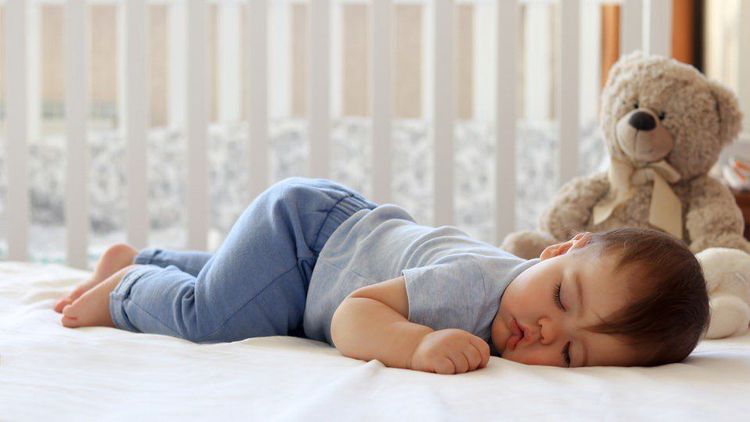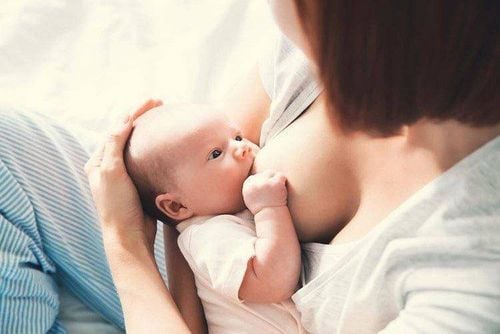This is an automatically translated article.
While many babies prefer to sleep on their side, some babies are placed on their back or stomach. Many opinions believe that sleeping on one side of an infant is the best choice to ensure the baby's sleep and safety. However, there is no single optimal sleeping position that can be applied to all babies.
1. The role of a safe sleeping position for babies
Newborns spend most of their time sleeping during the first few months of life. Sleep plays an important role in a child's development. Observation can see that many babies like to sleep on their side, while others choose to lie on their back or even on their stomach. A safe sleeping position needs attention and careful selection to protect the sleep of babies. According to statistics, many infant deaths due to sudden infant death syndrome (English name is sudden infant death syndrome) are related to unsafe sleeping positions. More than 80% of unexpected child deaths in the United States are classified as this syndrome.
Parents and caregivers need to understand the role a safe sleeping position plays in the health and well-being of babies. Choosing a safe sleeping position should be done under the guidance of doctors and experts with clear scientific evidence. The application of folklore or traditions has the potential to put children at risk. Some things should be avoided while the child sleeps to ensure the safety of the child such as:
Cover the infant's face and face with blankets, towels. This makes it easier for the child to get hot and more dangerous can suffocate. The child's bed is too soft, making it easy for the child to sink deep underneath, causing suffocation. If you choose to sleep on a sofa, soft mattress, or pillow, your baby needs to be carefully observed and monitored by an adult. Let the infant sleep alone. In the first months of life, the nervous system and the body's protective reflexes are not yet complete, so parents should not let the child sleep alone in the room to minimize the unfortunate accidents. Placing the child to sleep in a fixed position for too long such as lying on his stomach for a long time makes it difficult for him to breathe, lying on his back for a long time causes flattening of the occipital head...
Trắc nghiệm: các chỉ số cần chú ý về sự phát triển thể chất của trẻ
Chiều cao, cân nặng của bé ở từng giai đoạn nên là bao nhiêu là bình thường, bao nhiêu là bất thường? Cùng ThS.BS Ma Văn Thấm điểm lại xem bạn đã nắm được các chỉ số phát triển thể chất của bé chưa nhé!The following content is prepared under supervision of Thạc sĩ, Bác sĩ y khoa, Ma Văn Thấm , Nhi , Phòng khám Đa khoa Quốc tế Vinmec Dương Đông(Phú Quốc)
2. Why should babies sleep on their side when sleeping?
Many experts recommend that babies sleep on their side when sleeping is a good position with many benefits. Parents should put the child to lie down on one side and should wrap the child with a thin cloth, keep the arms and legs along the roller, giving the child a cozy and safe feeling when sleeping. Baby pillows can be used in combination to help your baby change his or her left-to-right position during sleep.
The outstanding benefit of putting a baby on his side is to keep the baby's airway safe. Newborns sleeping on their side are not at much of a risk of suffocation, especially when they vomit, food from the digestive tract does not go back up into the airways causing choking. Side lying position also plays a role in reducing snoring or wheezing while sleeping. However, lying on one side for too long can make the child's head flattened in the temple area or cause ear deformities, greatly affecting aesthetics.
Every sleeping position has its own benefits and risks. Determining a sleeping position of absolute benefit is impossible. Depending on the characteristics, age and health status of the child to choose the appropriate sleeping position. Newborns are too young to be able to change positions while sleeping like adults, so when taking care of children, parents need to remember to put the baby to sleep in many different positions, not maintain any fixed position. How to maximize the benefits and limit the disadvantages of each pose.

3. The benefits and risks of some other postures
In addition to lying on the side, when sleeping, babies can be placed in other positions such as:
Lying on their back: This is the natural sleeping position of all babies. Arms extended, elbows flexed and pointing upwards, legs slightly bent at knees and thighs. Caregivers of the infant should place a thin pillow under the infant's shoulder to keep the pharynx open and maintain a straight axis of the upper airway. In this position, the infant completely feels comfortable, relaxed, and supports breathing because the airway is kept open and creates favorable conditions for the care and hygiene of the baby's body. However, sleeping fixedly in the supine position for a long time makes the child's head prone to deformation due to occipital flatness, greatly affecting the shape of the head in adulthood and causing aesthetic loss. Tummy: Many babies prefer to sleep on their stomach because it creates a feeling of warmth and security. Babies sleeping on their stomachs should have their legs bent to their stomach at a moderate angle, no more than 90 degrees, with their hands placed at their sides comfortably. The prone position is considered akin to lying in the mother's womb, making the baby feel protected. In addition, this position also helps limit the regurgitation of food and digestive juices from the stomach back into the esophagus, stimulating the development of children by promoting movement, turning, turning over ... However , many experts do not recommend often for babies to lie on their stomach because there are many risks such as easy suffocation, heat caused by sweat accumulating in skin layers and difficulty evaporating, difficult to monitor children to detect signs. abnormal signal. Some infants with medical conditions being treated at medical centers will be placed in special positions, suitable for each different situation.

Pediatrics department at Vinmec International General Hospital is the address for receiving and examining diseases that infants and young children are susceptible to: viral fever, bacterial fever, otitis media, pneumonia in children, ... With modern equipment, sterile space, minimizing the impact as well as the risk of disease spread. Along with that is the dedication from the doctors with professional experience with pediatric patients, making the examination no longer a concern of the parents.
Please dial HOTLINE for more information or register for an appointment HERE. Download MyVinmec app to make appointments faster and to manage your bookings easily.














